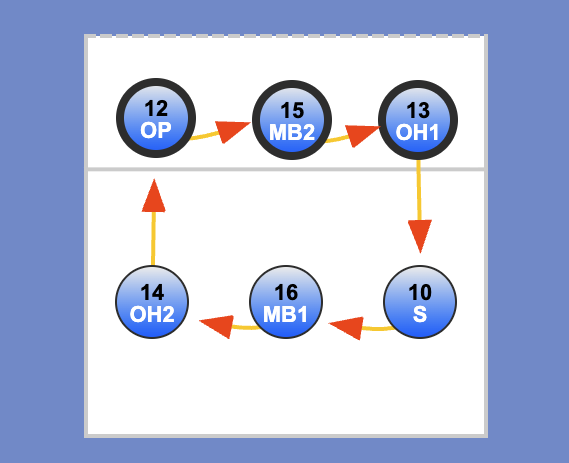Volleyball Positions and Rotations Explained (with Diagrams)
Master the fundamentals of volleyball rotations and court positions. Whether you're teaching the 5-1, 6-2, or 4-2 system, this guide helps you understand how rotations work and how to teach them effectively.
What Are Volleyball Rotations?
In volleyball, rotations refer to the clockwise movement of players on the court after winning a rally while the opposing team was serving. Each player rotates to the next position, ensuring everyone gets to play both front-row and back-row positions throughout a game.
The key rule governing rotations is the overlap rule: players must maintain their relative positions at the moment of serve. Front-row players must be in front of their corresponding back-row players, and players on the same row must maintain their left-to-right positions.

Volleyball court rotation showing clockwise movement through positions 1-6
Understanding rotations is essential for coaches and players to maintain legal positioning and maximize team effectiveness in each rotation.
Volleyball Rotation Systems
5-1 Rotation System
The 5-1 rotation is the most popular system in competitive volleyball. It uses one setter and five attackers. The single setter sets from all six rotations, meaning they set from the front row in three rotations and from the back row in the other three.
Advantages:
- Consistent setter for all plays
- Three attackers in the front row when setter is in back
- Most widely used in high school, club, and college volleyball
Best for: Teams with one dominant setter and strong outside hitters.
6-2 Rotation System
The 6-2 rotation uses two setters who only set from the back row. When a setter rotates to the front row, they become a hitter. This creates six potential attackers (hence "6-2").
Advantages:
- Always three front-row attackers
- More offensive options
- Good for teams with two capable setters
Best for: Teams with versatile players who can both set and hit.
4-2 Rotation System
The 4-2 rotation is the simplest system, using two setters who set from the front row. When the setter rotates to the back row, they become a passer/defender.
Advantages:
- Simple to learn and teach
- Good for beginning players
- Clear, defined roles
Best for: Youth teams and players learning volleyball fundamentals.
Court Positions Overview
The volleyball court has six positions, numbered 1-6, starting from the right back position and moving counterclockwise:
Position 4 (Left Front)
Outside hitter position. Primary attacker in most systems.
Position 3 (Middle Front)
Middle blocker position. Central to quick attacks and blocking schemes.
Position 2 (Right Front)
Right-side hitter position. Key for blocking the opponent's outside hitter.
Position 5 (Left Back)
Defensive specialist or libero position. Critical for serve receive and defense.
Position 6 (Middle Back)
Center back defensive position. Key for deep defensive coverage and a potential backrow hitter.
Position 1 (Right Back)
The serving position. Typically occupied by the setter or backrow opposite.
Teaching Rotations to Your Players
Teaching rotations effectively requires visual aids, repetition, and clear communication. Here are proven strategies for helping players understand rotations:
Use Visual Diagrams
Show players diagrams of each rotation before practice. Visual learners benefit from seeing the full picture of where they'll move throughout a game.
Walk Through Rotations
Physically walk players through rotations on the court without a ball. Have them practice moving to their next position after each rotation.
Practice Overlap Rules
Teach players to check their positions before each serve. Front-row players must be in front of respective back-row player, and side-to-side order must be maintained.
Use Consistent Systems
Stick to one offensive system for at least a season. Switching systems mid-season creates confusion and disrupts player confidence.
For more coaching tips and strategies, visit Volleyball Mentor for expert guidance.
Frequently Asked Questions About Volleyball Rotations
How many rotations are in volleyball?
There are six rotations in volleyball. Each player rotates through all six positions on the court during a full rotation cycle. Teams rotate clockwise when they win the serve back from the opponent.
Does your team rotate after you win a point while serving?
No, your team does not rotate after you win a point while serving. The rotation only occurs after you wins a point while the opponent is serving.
What's the difference between 5-1 and 6-2 rotations?
The 5-1 uses one setter who sets from all six rotations, giving you three front-row attackers when the setter is in the back row. The 6-2 uses two setters who only set from the back row, always providing three front-row attackers plus the back-row setter.
How do I fix overlap errors?
To avoid overlaps, ensure that at the moment of serve: (1) front-row players are closer to the net than their corresponding back-row players, and (2) players maintain their left-to-right order within their row. Using a rotation app like Rotate123 helps automatically highlight overlaps in red making it easy to visualize correct positioning.
When should players switch to specialized positions?
Players can move to their specialized positions immediately after the ball is contacted by the servers hand. Before the serve, they must maintain legal positioning according to overlap rules. After the serve, they're free to move anywhere on their side of the court.
Which rotation system is best for beginners?
The 6-6 is the most simple system, with everyone being a hitter or a setter depending on their location on the court. Commonly teams move to 4-2 rotation because it's the simplest to learn and players have clearly defined roles, and setters only set from the front row. As players develop, most teams transition to the 5-1 or 6-2 system.
Ready to plan your rotations?
Use Rotate123's visual lineup generator to build perfect rotations and eliminate overlap errors.